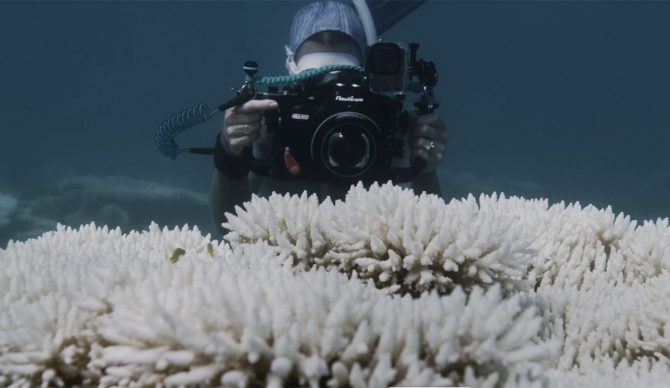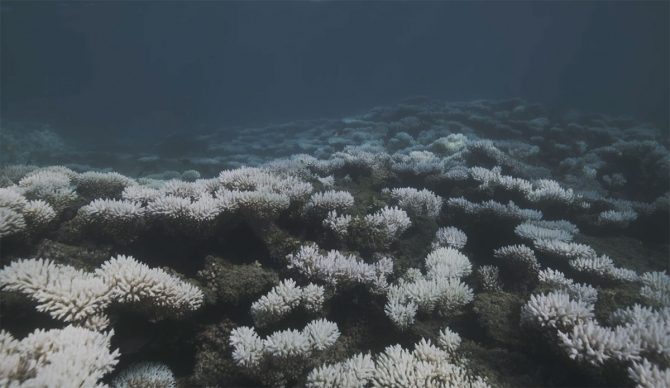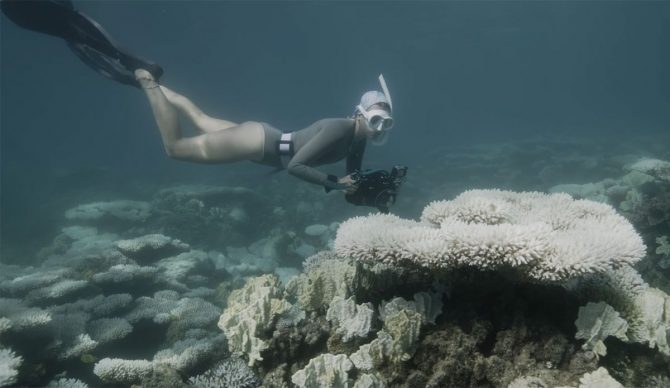
One of the most iconic reefs on Earth, Ningaloo Reef, is in serious trouble. Photo: Australian Marine Conservation Society
The iconic Ningaloo Reef is in trouble after a a vast underwater heatwave caused a devastating bleaching event. The reef, ghostly white instead of its usual vibrant rainbow of colors, was filmed by divers, and the footage is devastating.
“This is heartbreaking for all of us who love Ningaloo,” said Australian Marine Conservation Society, WA Director Paul Gamblin. “To see beautiful coral reefs bleaching white at Ningaloo icons, including Turquoise Bay, Coral Bay, and Bundegi, is just devastating.”
While coral bleaching does happen naturally and isn’t necessarily a death sentence, extended bleaching events are. When corals are stressed, they spit out the algae that lives in their tissues. That algae lives symbiotically with the corals, and is of vital importance to the ecosystem. Temperature, light, and drastic changes in nutrients can all cause coral bleaching. When the algae is expelled the corals turn white, which is where the term “bleaching” comes from.
In the wake of the footage, conservationists are calling for something to be done, instead of the usual lip-service.

The footage shows vast swaths of bleached coral. Photo: Australian Marine Conservation Society
“It demands urgent action from government, not business as usual,” Gamblin continued. “Large areas of coral could die in the weeks ahead. This is a red-alert moment for Ningaloo.”
The marine heatwave has been a devastating one. Reefs are hotbeds of marine activity – the foundation of entire ecosystems depend on them for shelter and food.
“This marine heatwave is like an underwater bushfire raging along Western Australia’s coast killing tens of thousands of fish that washed up on Pilbara beaches and now it’s cooking Ningaloo, the jewel in the crown,” Gamblin stated. “We called for the WA government to address this destructive marine heatwave weeks ago after the fish kill, and there has been silence at the ministerial level. Surely now that there is such widespread bleaching at Ningaloo, someone in government will step up.”
It’s not just conservationists that are concerned, either. Exmouth locals know the importance of the reef, and many of them rely on it in some way to survive.
“We know that many people in Exmouth are distressed by what they are witnessing, and they need and deserve a clear response from government,” Gamblin explained. “It’s also a stark reminder that coastal communities and their businesses, including the fishing industry and Ningaloo’s world-renowned tourism industry, rely on a healthy marine environment, and climate change poses an existential threat to them.”

A diver inspects the damage to parts of the iconic Ningaloo Reef. Photo: Australian Marine Conservation Society
Ningaloo Reef is just one of many reefs around the world in dire straits as the oceans warm and marine heatwaves become more prevalent and longer lasting. The Great Barrier Reef, for example, is sitting in water warmer than it has been in four centuries, and the effects are catastrophic.
“It’s time we listened to our scientists who have been warning for decades that climate change would threaten Ningaloo as it already has the Great Barrier Reef and many other coral reefs around the world,” Gamblin warned. “WA’s spectacular coast, so core to our identity and economy, is clearly not immune to the destructive impacts of climate change.”

